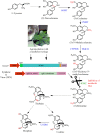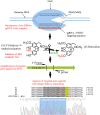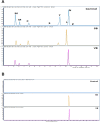Manipulating the Biosynthesis of Bioactive Compound Alkaloids for Next-Generation Metabolic Engineering in Opium Poppy Using CRISPR-Cas 9 Genome Editing Technology
- PMID: 27483984
- PMCID: PMC4971470
- DOI: 10.1038/srep30910
Manipulating the Biosynthesis of Bioactive Compound Alkaloids for Next-Generation Metabolic Engineering in Opium Poppy Using CRISPR-Cas 9 Genome Editing Technology
Abstract
Clustered regularly interspaced short palindromic repeats (CRISPR)/CRISPR-associated9 (Cas9) endonuclease system is a powerful RNA-guided genome editing tool. CRISPR/Cas9 has been well studied in model plant species for targeted genome editing. However, few studies have been reported on plant species without whole genome sequence information. Currently, no study has been performed to manipulate metabolic pathways using CRISPR/Cas9. In this study, the type II CRISPR/SpCas9 system was used to knock out, via nonhomologous end-joining genome repair, the 4'OMT2 in opium poppy (Papaver somniferum L.), a gene which regulates the biosythesis of benzylisoquinoline alkaloids (BIAs). For sgRNA transcription, viral-based TRV and synthetic binary plasmids were designed and delivered into plant cells with a Cas9 encoding-synthetic vector by Agrobacterium-mediated transformation. InDels formed by CRISPR/Cas9 were detected by sequence analysis. Our results showed that the biosynthesis of BIAs (e.g. morphine, thebaine) was significantly reduced in the transgenic plants suggesting that 4'OMT2 was efficiently knocked-out by our CRISPR-Cas9 genome editing approach. In addition, a novel uncharacterized alkaloid was observed only in CRISPR/Cas9 edited plants. Thus, the applicabilitiy of the CRISPR/Cas9 system was demonstrated for the first time for medicinal aromatic plants by sgRNAs transcribed from both synthetic and viral vectors to regulate BIA metabolism and biosynthesis.
Figures




References
-
- Chen K. & Gao C. Targeted Gene Mutation in Plants. in Somatic Genome Manipulation (eds Li X. Q. et al..), 253–272 (Springer, 2015).
Publication types
MeSH terms
Substances
LinkOut - more resources
Full Text Sources
Other Literature Sources
Research Materials

